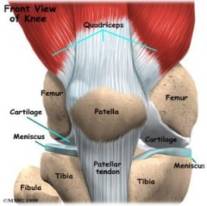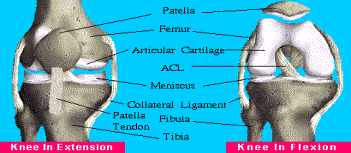
Our senior design project involves creating a device that will effectively resolve the problem of the bones in the knee joint from coming into direct contact. The direct contact is adverse because of the pain it causes. The engineering approach to the problem is to create a device that prohibits from occurring.
In order to develop a device that can meet the demand stated above, a full understanding of the knee and its functionality should be developed. By obtaining an understanding of the knee anatomy and how it works, the problem in a defective knee can be isolated and an engineering solution can be found.
The knee is one of the joints that bear the most body weight (3). A detailed depiction of the knee is given in figure 1. The knee is essentially constructed of four bones (1), ligaments, tendons, and cartilage (2). These bones include the femur, tibia, fibula, and patella. The femur is the large thighbone. The tibia is the larger bone in the lower leg. The fibula runs parallel to the tibia in the lower leg. The last bone is the patella or the kneecap (1, 2).

Figure 1:
Anatomy of Right Knee
The main stabilizers for the knee are the ligaments (1). The two main tendons in the knee are the ACL, Anterior Cruciate Ligament, and the PCL, Posterior Cruciate Ligament. These ligaments control the front to back motion of the knee joint. The Medial Collateral (MCL) and the Lateral Collateral Ligaments (LCL) prohibits extreme movement from side to side. The ligaments combined comprise the most important structures controlling the stability of the knee (2). All these ligaments are depicted in figure 2.
The last part of the knee consists of the cartilage. The points were the bones meet are covered with cartilage (1, 2, 3). The main cartilages in the knee joint are the meniscus cartilage and the articular cartilage. The articular cartilage’s function is to provide cushion and to reduce the friction between connecting bones. The meniscus is located on the top of the tibia. It has three major functions: stability, lubrication and nutrition, and shock absorption (4).

Figure 2: Anatomy of the Knee 2
Due to the complexity of the knee and its extensive use in everyday life, the knee is susceptible to various injuries. Some of the most common injuries associated with the knee are ligament tears, arthritis of the knee, meniscus cartilage tear, runners’ condition affecting the knee, and limited cartilage defects of the knee (5).
The most important ligament for stability in the knee and for a sense of well being is the anterior cruciate ligament (5). For this reason, a torn anterior cruciate ligament is routinely rebuilt utilizing a portion of the patella tendon or hamstring tendons. This usually results in a return to full functionality of the knee (5).
Overuse type syndromes affecting the knee are numerous (5). The more severe knee problems due to overuse are treated surgically. Inadequate training practice, worn running shoes, and the surface ran on can cause other knee conditions such as Iliotibial Band Syndrome or Pes Anserine Bursitis. Iliotibial Band Syndrome is an inflammatory condition affecting the exterior of the knee and causes a pain that is prevalent when running downhill. Pes Anserine Bursitis is similar to the previous condition except it is on the inner half of the knee (5).
A Meniscus Cartilage tear is just that; a tear in the Meniscus Cartilage. This is the most common condition of the knee that requires surgery. This procedure is termed an outpatient arthroscopic surgery. Usually, the patient returns home in the same day. The patients are usually advised to walk on the leg as soon as it feels comfortable (5).
The most common ailment to the knee that causes discomfort and pain is arthritis (6). Osteoarthritis of the knee is the one considered in this project. Osteoarthritis of the knee is an arthritic condition in which the protective cartilage erodes. As the cartilage deteriorates, the bones begin to come in contact and the friction causes pain, swelling, and inactivity (6). Common treatment of this disease is an invasive surgery. Elderly people are adverse to surgery because of the increased risk at an older age. In addition to this, the chances of recovery are less likely with increased. Therefore, an alternative to surgery is necessary (4).
In conclusion, there are many problems associated with the knee that induce pain. Through research it was found that Arthritis is the leading cause in discomfort and pain associated with the knee. Furthermore, this ailment results in increased inactivity. Our goal as engineers is to resolve this problem by finding an alternative to surgery. We essentially will create a device that will prevent the two major bones involved in the knee joint (femur and tibia) from coming in contact.